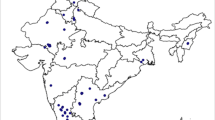Abstract
Twenty-two aflatoxin B1 (AFB1) producing Aspergillus flavus strains were isolated from 1,200 discolored rice grain samples collected from 20 states across India and tested their potential to produce AFB1 on different agar media. Further these isolates were characterized through randomly amplified polymorphic DNA method. All the strains of A. flavus were produced AFB1 on yeast extract sucrose agar media and none of the strains on A. flavus and A. parasiticus agar. Among the 22 strains, two strains from Tamil Nadu (DRAf 009) and Maharashtra (DRAf 015) produced high amount of AFB1 in all the media tested. To assess the genetic variability in A. flavus, the isolates were analyzed by using random amplified polymorphic DNA markers. Isolates showed 17–80% similarity with standard culture of A. flavus (MTCC 2799).


Similar content being viewed by others
References
Aufauvre BA, Cohen J, Holden DW (1992) Use of randomly amplified polymorphic DNA markers to distinguish isolates of Aspergillus fumigatus. J Clin Microbiol 30:2991–2993
Bars LJ, Bars LP (1992) Fungal contamination of aromatic herbs, aflatoxinogenesis and residues in infusions. Microbiol Aliments Nutr 10:267–271
Carballo M, Miguel JA (1987) Rapid detection of aflatoxin-producing strains of the Aspergillus flavus group isolated from mixed feed and cereal grain in Spain. J Sci Food Agric 40(1):11–15. doi:10.1002/jsfa.2740400103
Cotty PJ (1994) Comparison of four media for the isolation of Aspergillus flavus group fungi. Mycopathologia 125(3):57–62. doi:10.1007/BF01146521
Devi KT, Mayo MA, Reddy KLN, Delfosse P, Reddy G, Reddy SV et al (1999) Production and characterization of monoclonal antibodies for aflatoxin B1. Lett Appl Microbiol 29:284–288. doi:10.1046/j.1472-765X.1999.00685.x
Devi KT, Mayo MA, Reddy G, Emmanuel KE, Larondelle Y, Reddy DVR (2001) Occurrence of ochratoxin A in black pepper, coriander, ginger and turmeric in India. Food Addit Contam 18(9):830–835. doi:10.1080/02652030110044921
Fente CA, Ordaz J, Vazquez QI, Franco CM, Cepeda A (2001) New additive for culture media for rapid identification of aflatoxin producing Aspergillus strains. Appl Environ Microbiol 67(10):4858–4862. doi:10.1128/AEM.67.10.4858-4862.2001
TA IS (1966) International rules for seed testing. Proc Int Seed Test Assoc 31:49–85
Klich MA (2002) Identification of common Aspergillus species. Centraal Bureau Voor Schimmel cultures, AD Utrecht, p 116
Kurtzman CP, Robnett MJ, Wicklow DT (1986) DNA relatedness among wild and domesticated species in the Aspergillus flavus group. Mycologia 78:955–959. doi:10.2307/3807436
Lee WV (1965) Quantitative determination of aflatoxin in groundnut products. Analyst (Lond) 90:305–307. doi:10.1039/an9659000305
Lee CZ, Liou GY, Yuan GF (2004) Comparison of Aspergillus flavus and A. oryzae by amplified fragment length polymorphism. Bot Bull Acad Sin 45:61–68
Liu Z, Gao J, Yu J (2006) Aflatoxins in stored maize and rice grains in Liaoning province, China. J Stored Prod Res 42:468–479. doi:10.1016/j.jspr.2005.09.003
Manisha RD, Sandip G (2003) Occupational exposure to airborne fungi among rice mill workers with special reference to aflatoxin producing A. flavus strains. Ann Agric Environ Med 10:159–162
Moody SF, Tyler BM (1990) Use of nuclear DNA restriction fragment length polymorphisms to analyze the diversity of the Aspergillus flavus group. Appl Environ Microbiol 56:2441–2452
Raper KB, Fennell DI (1965) The genus Aspergillus. Williams and Wilkins, Baltimore, p 686
Rath PM (2001) Phenotypic and genotypic characterization of reference strains of the genus Aspergillus. Mycoses 44:65–72. doi:10.1046/j.1439-0507.2001.00620.x
Rath PM, Petermeier K, Paul E, Ansorg R (2002) Differentiation of Aspergillus ustus strains by random amplification of polymorphic DNA. J Clin Microbiol 40(6):2231–2233. doi:10.1128/JCM.40.6.2231-2233.2002
Reddy BN, Raghavender CR (2007) Outbreaks of aflatoxicoses in India. Afr J Food Agric Nutr Dev 7 (5): http://www.ajfand.net/Issue16/PDFs/Reddy_2750.pdf Accessed 4 May 2008
Reddy CS, Reddy KRN, Raja Kumar N, Laha GS, Muralidharan K (2004) Exploration of aflatoxin contamination and its management in rice. J Mycol Pl Pathol 34(3):816–820
Reddy KRN, Reddy CS, Muralidharan K (2005) Characterization of AFB1 produced by A. flavus isolated from discolored rice grains. J Mycol Pl Pathol 35(3):470–474
Rohlf FJ (2000) NTSYS-PC: numerical taxonomy and multivariate analysis system, version 3.21. Exeter Publications, New York
Shotwell OL, Hesseltine CW, Stubblefieldand RD, Sorenson WG (1966) Production of aflatoxin on rice. Appl Microbiol 14:425–428
Tanaka K, Sago Y, Zheng Y, Nakagawa H, Kushiro M (2007) Mycotoxins in rice. Int J Food Microbiol 119:59–66. doi:10.1016/j.ijfoodmicro.2007.08.002
Teresa MD, Mellado E, Manuel CE, Lourdes G, Navarro JIV, Rodriguez T (2000) Genetic similarity among one A. flavus strain isolated from a patient who underwent heart surgery and two environmental strains obtained from the operating room. J Clin Microbiol 36(6):2241–2248
Williams JGK, Kubelik AR, Livak KJ, Rafalski JA, Tingey SV (1990) DNA polymorphisms amplified by arbitrary primers are useful as genetic markers. Nucleic Acids Res 18:6531–6535. doi:10.1093/nar/18.22.6531
Yuan GF, Liu CS, Chen CC (1995) Differentiation of Aspergillus parasiticus from Aspergillus sojae by random amplification of polymorphic DNA. Appl Environ Microbiol 61:2384–2387
Acknowledgement
The authors are thankful to Indian Council of Agricultural Research (ICAR), New Delhi for providing funds through Aflatoxin network project.
Author information
Authors and Affiliations
Corresponding author
Rights and permissions
About this article
Cite this article
Reddy, K.R.N., Surendhar Reddy, C., Nataraj Kumar, P. et al. Genetic variability of aflatoxin B1 producing Aspergillus flavus strains isolated from discolored rice grains. World J Microbiol Biotechnol 25, 33–39 (2009). https://doi.org/10.1007/s11274-008-9857-5
Received:
Accepted:
Published:
Issue Date:
DOI: https://doi.org/10.1007/s11274-008-9857-5




